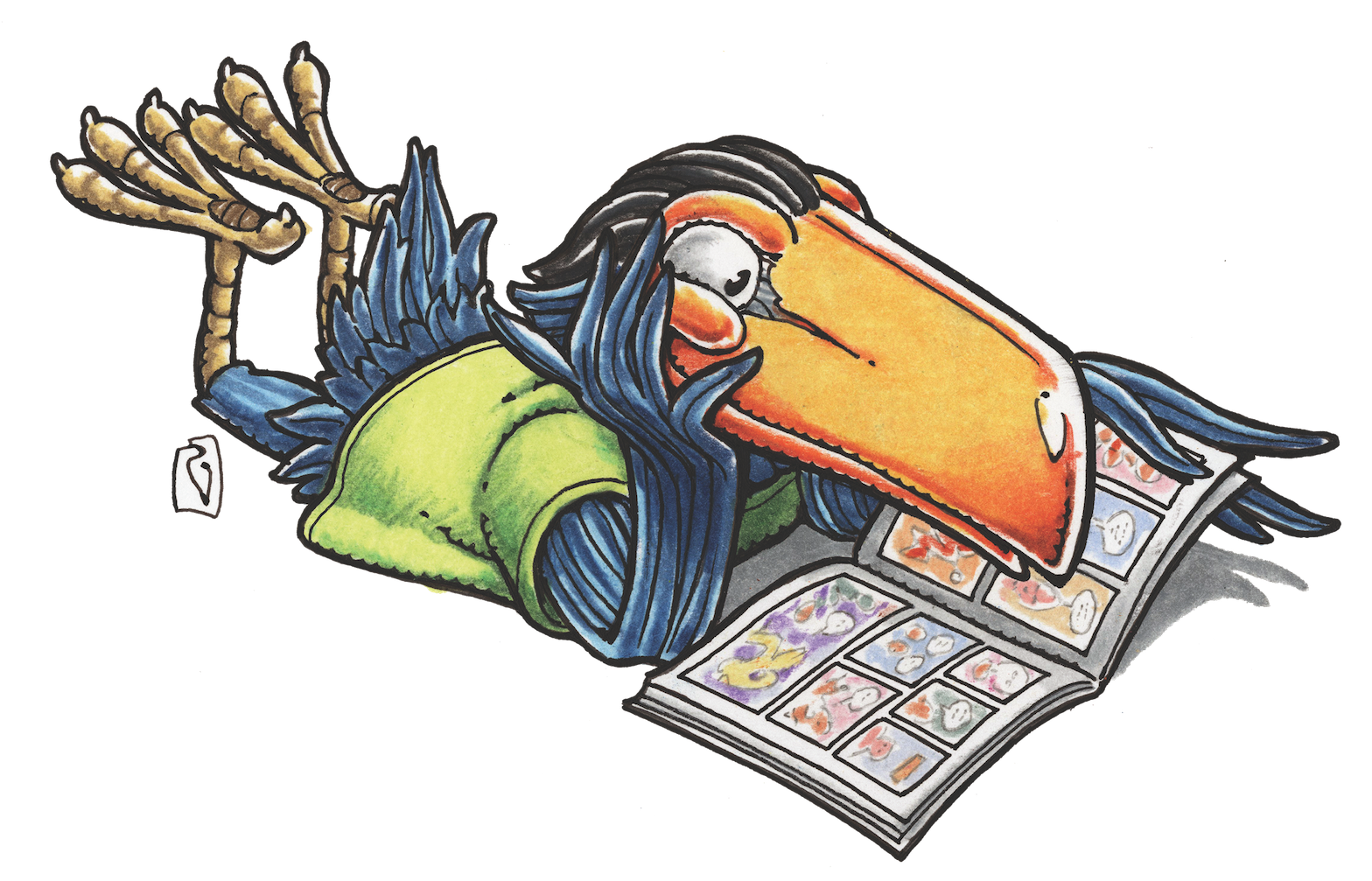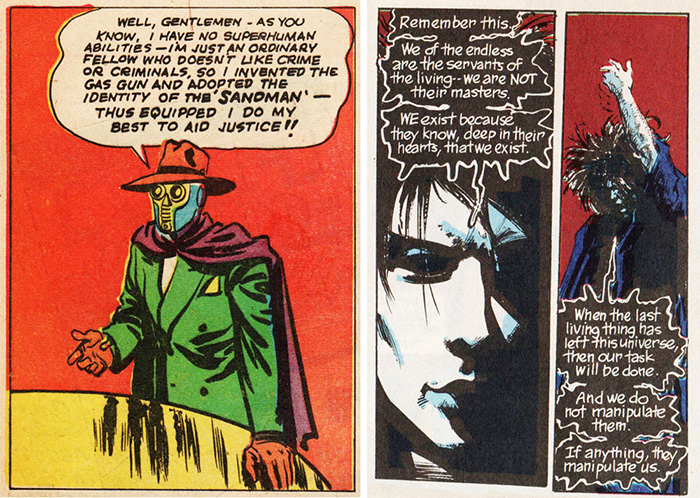MAGGIE’S WORLD BY MAGGIE THOMPSON
Maggie’s World 035: Changes

As 2015 began to wrap up, I was thinking about the assortment of wonderful comics released during the year—and that led me to memories of the successes of comics in other media. That, in turn, reminded me that many folks’ earliest exposure to comic book characters has been in other forms. Which, in turn, can lock their expectations into what they think a character “should” be.
Frequently, what attracts a fan to a comics character in the first place is dropped in later versions, whether in comic books or not. And all that leads me to my current theory: The character that especially resonates with us at ages 10-12 tends to be the version that we consider the “real” character.

For Example
There’s Plastic Man. Though the folks at Quality clearly thought The Firebrand was going to be their breakout star, Plastic Man was also introduced in Police Comics #1 (August 1941). Jack Cole dreamed him up before I was born—but Plas and Woozy Winks were still clowning around by the time I had my disposable income of a dime a week.
He was a superhero whose stretchy form allowed for a variety of sight gags just right for me as a kid. For that reason, those stories continue to resonate for me today. Let’s face it: If you seriously consider stretchiness to be an actual human ability, you’ve tossed a bunch of natural laws out of the window.
While Quality left the field following the advent of the Comics Code, the lure of the stretchy guy remained. DC gave us Elongated Man in 1960. Marvel offered Mister Fantastic the next year. And DC brought back the Quality character himself (sort of) in House of Mystery #160 (July 1966) via the Robby Reed “Dial H for Hero” (Sockamagee!) story.
Among my favorites from DC, it’s Kyle Baker’s version in 2004 that remains dear. Nevertheless, when I think of “my” Plastic Man, it’s Jack Cole’s stories that spring to mind.

Second-string Characters
How much do you know about the Golden Age Robotman? He was just a guy (Dr. Robert Crane, later adopting the name Paul Dennis) whose brain was transplanted into a cyborg body (hey, it happens) in DC’s Star Spangled Comics #7 (April 1942) in a story by Jerry Siegel and Leo Nowak. His adventures had been running for years by the time I was reading them in Detective Comics, where they ran till #202 (December 1953). He was perky, thoughtful, amiable, and helpful: Sort of the way you’d like to think you’d be under the circumstances.
When DC introduced a Silver Age version of Robotman in My Greatest Adventure #80 (June 1963) in a story by Arnold Drake, Bob Haney, and Bruno Premiani, he had a different identity (Cliff Steele). Yes, it was another brain-in-a-metal-body hero—but with a difference. This guy was depressed, more of a serious action guy, and joined the Doom Patrol with another bunch of occasionally angry super-folks. (What do you expect from characters whose self-image is that of a Doom Patrol?)
There are clearly many directions that creators can take with this sort of idea. (Note, for example, the Doom Patrol’s opponent supervillain, The Brain—just another solo brain, but that guy spent most of his time in a jar.)
[To digress: It should be noted here that both the Golden Age and Silver Age characters of Robotman were introduced before the brain-in-a-metal-body known as a Cyberman was created by Kit Pedler and Gerry Davis for “The Tenth Planet.” That serial began October 8, 1966, on the BBC-TV series Doctor Who. Do you suppose Pedler and Davis had read either of the comic-book versions? (A further footnote: That was the serial that revamped another pop-culture icon, when The Doctor regenerated from actor William Hartnell to actor Patrick Troughton. End of the digression’s digression.)]

Sometimes It’s Mostly the Name
Perhaps the best theme-and-variations is another DC character: Sandman. In the Golden Age, he was Wesley Dodds, created in 1939 by Gardner Fox and Bert Christman for New York World’s Fair #1 and Adventure Comics #40 (July)—lasting through #102 (March 1945)—and he had a sleeping-gas gun to remove bad guys as a threat. (He also founded the Justice Society of America, but I digress again.) He popped up in the Silver Age in Justice League of America #46 (August 1966). And DC revisited Dodds’ comics career in Sandman Mystery Theatre (April 1993).
But you know what I’m talking about, right? While retaining the character’s connection to Dodds, Neil Gaiman made a radical departure with The Sandman #1 (January 1989).
And, while I’d come across the Golden Age character in my pre-teen years, he’d never resonated. So it’s Gaiman’s creation that remains “my” Sandman.
Those Are Only a Few
There are more, more, more. Fawcett’s Captain Marvel. DC’s Tommy Tomorrow. Green Arrow. Heck, Marvel’s Captain Marvel, come to think of it.
Intriguingly, Marvel’s Sub-Mariner and Captain America were brought back as their Golden Age selves. Because comic books. But Marvel’s Golden Age Human Torch (who wasn’t human, come to think of it) was a sort of wiser big brother who spent many dialogue balloons explaining the action to the young, hotheaded Toro. Whereas the Silver Age Torch originated as, yes, a young hothead.
“My” Donald Duck was the comic-book version by the ever-inventive Carl Barks. Because I saw the animated version only now and then, but Walt Disney’s Comics and Stories arrived in my mailbox every month. And, for that matter, “my” Mickey Mouse was the guy in that title’s adaptations of the Floyd Gottfredson daily strips. I had no idea at the time that those Comics and Stories back-ups weren’t original to the comic book.
Your mileage may vary in these and other cases, of course. Keep in mind that a fresh take on fictional characters will probably either fascinate or offend their original admirers. And the fresh take will also be compared to and contrasted with the original.
(Is this the time to confess that “my” Tarzan is the one in the Dell series? Which was scripted by Gaylord DuBois and drawn by Jesse Marsh, who were told to base the character on the Lex Barker movies? Yeah, I thought not. Never mind.)
Maggie’s World by Maggie Thompson appears the first Tuesday of every month here on Toucan!